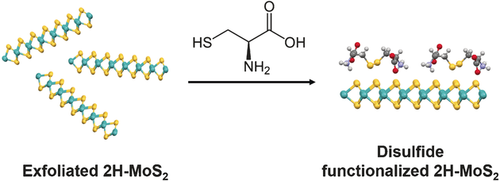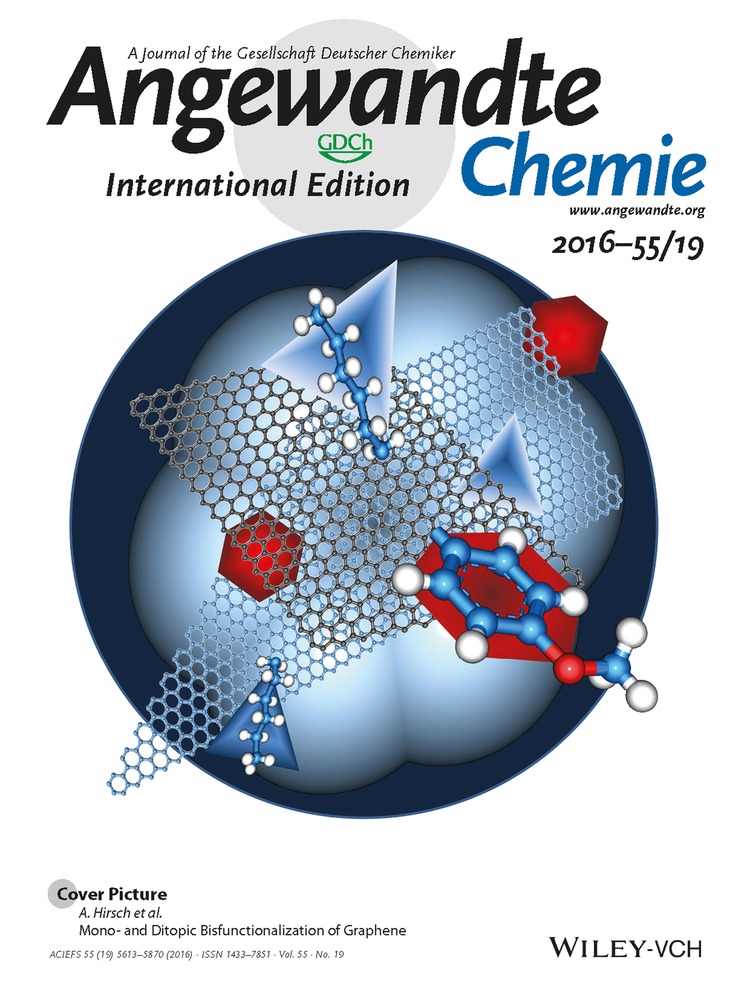Functionalization of Two-Dimensional MoS2: On the Reaction Between MoS2 and Organic Thiols
Xin Chen
CRANN/AMBER Nanoscience Institute, Trinity College Dublin, The University of Dublin, College Green, Dublin, 2 Ireland
School of Chemistry, Trinity College Dublin
Search for more papers by this authorDr. Nina C. Berner
CRANN/AMBER Nanoscience Institute, Trinity College Dublin, The University of Dublin, College Green, Dublin, 2 Ireland
School of Chemistry, Trinity College Dublin
Search for more papers by this authorDr. Claudia Backes
CRANN/AMBER Nanoscience Institute, Trinity College Dublin, The University of Dublin, College Green, Dublin, 2 Ireland
School of Physics, Trinity College Dublin
Search for more papers by this authorProf. Dr. Georg S. Duesberg
CRANN/AMBER Nanoscience Institute, Trinity College Dublin, The University of Dublin, College Green, Dublin, 2 Ireland
School of Chemistry, Trinity College Dublin
Search for more papers by this authorCorresponding Author
Dr. Aidan R. McDonald
CRANN/AMBER Nanoscience Institute, Trinity College Dublin, The University of Dublin, College Green, Dublin, 2 Ireland
School of Chemistry, Trinity College Dublin
Search for more papers by this authorXin Chen
CRANN/AMBER Nanoscience Institute, Trinity College Dublin, The University of Dublin, College Green, Dublin, 2 Ireland
School of Chemistry, Trinity College Dublin
Search for more papers by this authorDr. Nina C. Berner
CRANN/AMBER Nanoscience Institute, Trinity College Dublin, The University of Dublin, College Green, Dublin, 2 Ireland
School of Chemistry, Trinity College Dublin
Search for more papers by this authorDr. Claudia Backes
CRANN/AMBER Nanoscience Institute, Trinity College Dublin, The University of Dublin, College Green, Dublin, 2 Ireland
School of Physics, Trinity College Dublin
Search for more papers by this authorProf. Dr. Georg S. Duesberg
CRANN/AMBER Nanoscience Institute, Trinity College Dublin, The University of Dublin, College Green, Dublin, 2 Ireland
School of Chemistry, Trinity College Dublin
Search for more papers by this authorCorresponding Author
Dr. Aidan R. McDonald
CRANN/AMBER Nanoscience Institute, Trinity College Dublin, The University of Dublin, College Green, Dublin, 2 Ireland
School of Chemistry, Trinity College Dublin
Search for more papers by this authorGraphical Abstract
An unexpected appendage: In the functionalization of 2D MoS2 with organic thiols, thiols were oxidized to disulfides, rather than coordinating at S-vacancies on the MoS2 surface, as originally conceived. The oxidation was facilitated by MoS2, resulting in a high density of organic disulfides docked on the MoS2 surface.
Abstract
Two-dimensional layered transition metal dichalcogenides (TMDs) have attracted great interest owing to their unique properties and a wide array of potential applications. However, due to their inert nature, pristine TMDs are very challenging to functionalize. We demonstrate a general route to functionalize exfoliated 2H-MoS2 with cysteine. Critically, MoS2 was found to be facilitating the oxidation of the thiol cysteine to the disulfide cystine during functionalization. The resulting cystine was physisorbed on MoS2 rather than coordinated as a thiol (cysteine) filling S-vacancies in the 2H-MoS2 surface, as originally conceived. These observations were found to be true for other organic thiols and indeed other TMDs. Our findings suggest that functionalization of two-dimensional MoS2 using organic thiols may not yield covalently or datively tethered functionalities, rather, in this instance, they yield physisorbed disulfides that are easily removed.
Supporting Information
As a service to our authors and readers, this journal provides supporting information supplied by the authors. Such materials are peer reviewed and may be re-organized for online delivery, but are not copy-edited or typeset. Technical support issues arising from supporting information (other than missing files) should be addressed to the authors.
| Filename | Description |
|---|---|
| anie201510219-sup-0001-misc_information.pdf2 MB | Supplementary |
Please note: The publisher is not responsible for the content or functionality of any supporting information supplied by the authors. Any queries (other than missing content) should be directed to the corresponding author for the article.
References
- 1H. Zhang, K. P. Loh, C. H. Sow, H. Gu, X. Su, C. Huang, Z. K. Chen, Langmuir 2004, 20, 6914–6920.
- 2B. Radisavljevic, A. Radenovic, J. Brivio, V. Giacometti, A. Kis, Nat. Nanotechnol. 2011, 6, 147–150.
- 3G. Eda, H. Yamaguchi, D. Voiry, T. Fujita, M. Chen, M. Chhowalla, Nano Lett. 2011, 11, 5111–5116.
- 4Y. Li, H. Wang, L. Xie, Y. Liang, G. Hong, H. Dai, J. Am. Chem. Soc. 2011, 133, 7296–7299.
- 5K.-K. Liu, W. Zhang, Y.-H. Lee, Y.-C. Lin, M.-T. Chang, C.-Y. Su, C.-S. Chang, H. Li, Y. Shi, H. Zhang, C.-S. Lai, L.-J. Li, Nano Lett. 2012, 12, 1538–1544.
- 6T. Cao, G. Wang, W. Han, H. Ye, C. Zhu, J. Shi, Q. Niu, P. Tan, E. Wang, B. Liu, J. Feng, Nat. Commun. 2012, 3, 887.
- 7K. F. Mak, K. He, J. Shan, T. F. Heinz, Nat. Nanotechnol. 2012, 7, 494–498.
- 8H. Zeng, J. Dai, W. Yao, D. Xiao, X. Cui, Nat. Nanotechnol. 2012, 7, 490–493.
- 9H. J. Conley, B. Wang, J. I. Ziegler, R. F. Haglund, S. T. Pantelides, K. I. Bolotin, Nano Lett. 2013, 13, 3626–3630.
- 10K. Lee, R. Gatensby, N. McEvoy, T. Hallam, G. S. Duesberg, Adv. Mater. 2013, 25, 6699–6702.
- 11V. Nicolosi, M. Chhowalla, M. G. Kanatzidis, M. S. Strano, J. N. Coleman, Science 2013, 340, 1420.
- 12X. Chen, A. R. McDonald, Adv. Mater. 2016, DOI: 10.1002/adma.201505345.
- 13Q. H. Wang, K. Kalantar-Zadeh, A. Kis, J. N. Coleman, M. S. Strano, Nat. Nanotechnol. 2012, 7, 699–712.
- 14M. Chhowalla, H. S. Shin, G. Eda, L.-J. Li, K. P. Loh, H. Zhang, Nat. Chem. 2013, 5, 263–275.
- 15J. N. Coleman, M. Lotya, A. O'Neill, S. D. Bergin, P. J. King, U. Khan, K. Young, A. Gaucher, S. De, R. J. Smith, I. V. Shvets, S. K. Arora, G. Stanton, H.-Y. Kim, K. Lee, G. T. Kim, G. S. Duesberg, T. Hallam, J. J. Boland, J. J. Wang, J. F. Donegan, J. C. Grunlan, G. Moriarty, A. Shmeliov, R. J. Nicholls, J. M. Perkins, E. M. Grieveson, K. Theuwissen, D. W. McComb, P. D. Nellist, V. Nicolosi, Science 2011, 331, 568–571.
- 16H. Li, Z. Yin, Q. He, H. Li, X. Huang, G. Lu, D. W. H. Fam, A. I. Y. Tok, Q. Zhang, H. Zhang, Small 2012, 8, 63–67.
- 17Y. Zhan, Z. Liu, S. Najmaei, P. M. Ajayan, J. Lou, Small 2012, 8, 966–971.
- 18M. O'Brien, N. McEvoy, T. Hallam, H.-Y. Kim, N. C. Berner, D. Hanlon, K. Lee, J. N. Coleman, G. S. Duesberg, Sci. Rep. 2014, 4, 7374.
- 19C. Yim, M. O'Brien, N. McEvoy, S. Riazimehr, H. Schäfer-Eberwein, A. Bablich, R. Pawar, G. Iannaccone, C. Downing, G. Fiori, M. C. Lemme, G. S. Duesberg, Sci. Rep. 2014, 4, 5458.
- 20Z. Zeng, Z. Yin, X. Huang, H. Li, Q. He, G. Lu, F. Boey, H. Zhang, Angew. Chem. Int. Ed. 2011, 50, 11093–11097; Angew. Chem. 2011, 123, 11289–11293.
- 21A. Splendiani, L. Sun, Y. Zhang, T. Li, J. Kim, C.-Y. Chim, G. Galli, F. Wang, Nano Lett. 2010, 10, 1271–1275.
- 22K. F. Mak, C. Lee, J. Hone, J. Shan, T. F. Heinz, Phys. Rev. Lett. 2010, 105, 136805.
- 23K. C. Knirsch, N. C. Berner, H. C. Nerl, C. S. Cucinotta, Z. Gholamvand, N. McEvoy, Z. Wang, I. Abramovic, P. Vecera, M. Halik, S. Sanvito, G. S. Duesberg, V. Nicolosi, F. Hauke, A. Hirsch, J. N. Coleman, C. Backes, ACS Nano 2015, 9, 6018–6030.
- 24D. Voiry, A. Goswami, R. Kappera, C. de Carvalho Castro e Silva, D. Kaplan, T. Fujita, M. Chen, T. Asefa, M. Chhowalla, Nat. Chem. 2015, 7, 45–49.
- 25C. Backes, N. C. Berner, X. Chen, P. Lafargue, P. LaPlace, M. Freeley, G. S. Duesberg, J. N. Coleman, A. R. McDonald, Angew. Chem. Int. Ed. 2015, 54, 2638–2642; Angew. Chem. 2015, 127, 2676–2680.
- 26S. S. Chou, M. De, J. Kim, S. Byun, C. Dykstra, J. Yu, J. Huang, V. P. Dravid, J. Am. Chem. Soc. 2013, 135, 4584–4587.
- 27M. Makarova, Y. Okawa, M. Aono, J. Phys. Chem. C 2012, 116, 22411–22416.
- 28S.-D. Jiang, G. Tang, Z.-M. Bai, Y.-Y. Wang, Y. Hu, L. Song, RSC Adv. 2014, 4, 3253–3262.
- 29L. Zhou, B. He, Y. Yang, Y. He, RSC Adv. 2014, 4, 32570–32578.
- 30R. Anbazhagan, H.-J. Wang, H.-C. Tsai, R.-J. Jeng, RSC Adv. 2014, 4, 42936–42941.
- 31J.-S. Kim, H.-W. Yoo, H. O. Choi, H.-T. Jung, Nano Lett. 2014, 14, 5941–5947.
- 32Z. Yu, Y. Pan, Y. Shen, Z. Wang, Z.-Y. Ong, T. Xu, R. Xin, L. Pan, B. Wang, L. Sun, J. Wang, G. Zhang, Y. W. Zhang, Y. Shi, X. Wang, Nat. Commun. 2014, 5, 5290.
- 33T. Liu, S. Shi, C. Liang, S. Shen, L. Cheng, C. Wang, X. Song, S. Goel, T. E. Barnhart, W. Cai, Z. Liu, ACS Nano 2015, 9, 950–960.
- 34E. P. Nguyen, B. J. Carey, J. Z. Ou, J. van Embden, E. D. Gaspera, A. F. Chrimes, M. J. S. Spencer, S. Zhuiykov, K. Kalantar-zadeh, T. Daeneke, Adv. Mater. 2015, 27, 6224–6229.
- 35K. Cho, M. Min, T.-Y. Kim, H. Jeong, J. Pak, J.-K. Kim, J. Jang, S. J. Yun, Y. H. Lee, W.-K. Hong, T. Lee, ACS Nano 2015, 9, 8044–8053.
- 36M. Donarelli, F. Bisti, F. Perrozzi, L. Ottaviano, Chem. Phys. Lett. 2013, 588, 198–202.
- 37H. Qiu, T. Xu, Z. Wang, W. Ren, H. Nan, Z. Ni, Q. Chen, S. Yuan, F. Miao, F. Song, G. Long, Y. Shi, L. Sun, J. Wang, X. Wang, Nat. Commun. 2013, 4, 2642.
- 38H.-P. Komsa, S. Kurasch, O. Lehtinen, U. Kaiser, A. V. Krasheninnikov, Phys. Rev. B 2013, 88, 035301.
- 39C. Backes, R. J. Smith, N. McEvoy, N. C. Berner, D. McCloskey, H. C. Nerl, A. O'Neill, P. J. King, T. Higgins, D. Hanlon, N. Scheuschner, J. Maultzsch, L. Houben, G. S. Duesberg, J. F. Donegan, V. Nicolosi, J. N. Coleman, Nat. Commun. 2014, 5, 4576.
- 40G. Berhault, L. Cota Araiza, A. Duarte Moller, A. Mehta, R. Chianelli, Catal. Lett. 2002, 78, 81–90.
- 41A. Pawlukojć, J. Leciejewicz, A. J. Ramirez-Cuesta, J. Nowicka-Scheibe, Spectrochim. Acta Part A 2005, 61, 2474–2481.
- 42X. Zhang, X.-F. Qiao, W. Shi, J.-B. Wu, D.-S. Jiang, P.-H. Tan, Chem. Soc. Rev. 2015, 44, 2757–2785.
- 43M. A. Pimenta, E. del Corro, B. R. Carvalho, C. Fantini, L. M. Malard, Acc. Chem. Res. 2015, 48, 41–47.
- 44This is evident in features in the Mo 3d core level spectra identified at 229.0 and 232.1 eV for Mo 3d5/2 and Mo 3d3/2 respectively (Figure 3 a). If it were 1T-MoS2, features at 228.6 and 231.7±0.15 eV would be expected, supporting our UV/Vis observations.
- 45A mild broadening of the S 2p component attributed to 2H-MoS2 (161.8 eV) is not significant enough to suggest chemical modification.
- 46W. Zhang, Y. Wang, D. Zhang, S. Yu, W. Zhu, J. Wang, F. Zheng, S. Wang, J. Wang, Nanoscale 2015, 7, 10210–10217.
- 47E. J. Bastian, R. B. Martin, J. Phys. Chem. 1973, 77, 1129–1133.
- 48B. S. Zelakiewicz, G. C. Lica, M. L. Deacon, Y. Y. Tong, J. Am. Chem. Soc. 2004, 126, 10053–10058.





